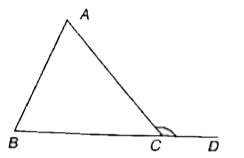In a triangle ABC, the side BC is extended up to D. Such that CD=AC, if ∠BAD=109∘ and ∠ACB=72∘ then the value of ∠ABCis
35∘
60∘
40∘
45∘
The correct Answer is:A
To solve the problem step by step, we will analyze the triangle ABC with the given conditions.
Step 1: Draw the Diagram
Draw triangle ABC and extend side BC to point D such that CD = AC. Mark the angles as given: ∠BAD = 109° and ∠ACB = 72°.
Hint: Always start by visualizing the problem with a diagram. It helps in understanding the relationships between the angles and sides.
Step 2: Identify Isosceles Triangle
Since CD = AC, triangle ACD is isosceles. Therefore, the angles opposite to equal sides are equal. Let the angles ∠CAD and ∠CDA both be θ.
Hint: Recall that in an isosceles triangle, the angles opposite the equal sides are equal.
Step 3: Set Up the Equation for Angles in Triangle ACD
The sum of angles in triangle ACD is:
∠CAD+∠ACD+∠CDA=180°
Substituting the known values:
θ+72°+θ=180°
This simplifies to:
2θ+72°=180°
Hint: Use the property that the sum of angles in a triangle is always 180°.
Step 4: Solve for θ
Rearranging the equation gives:
2θ=180°−72°
2θ=108°
θ=54°
Hint: Isolate the variable to find its value.
Step 5: Analyze Triangle ABD
Now, consider triangle ABD. We know:
- ∠BAD = 109°
- ∠CAD = θ = 54°
Let ∠ABC = α (the angle we want to find). The sum of angles in triangle ABD gives us:
∠BAD+∠ABC+∠CAD=180°
Substituting the known values:
109°+α+54°=180°
Hint: Again, apply the triangle angle sum property.
Step 6: Solve for α
Rearranging the equation gives:
α=180°−109°−54°
α=180°−163°
α=17°
Hint: Carefully perform the arithmetic to ensure accuracy.
Final Answer
Thus, the value of ∠ABC is:
17°
Draw triangle ABC and extend side BC to point D such that CD = AC. Mark the angles as given: ∠BAD = 109° and ∠ACB = 72°.
Since CD = AC, triangle ACD is isosceles. Therefore, the angles opposite to equal sides are equal. Let the angles ∠CAD and ∠CDA both be θ.
The sum of angles in triangle ACD is:
∠CAD+∠ACD+∠CDA=180°
Substituting the known values:
θ+72°+θ=180°
This simplifies to:
2θ+72°=180°
Rearranging the equation gives:
2θ=180°−72°
2θ=108°
θ=54°
Now, consider triangle ABD. We know:
- ∠BAD = 109°
- ∠CAD = θ = 54°
∠BAD+∠ABC+∠CAD=180°
Substituting the known values:
109°+α+54°=180°
Rearranging the equation gives:
α=180°−109°−54°
α=180°−163°
α=17°
Thus, the value of ∠ABC is:
17°
Topper's Solved these Questions
- BOOK - KIRAN PUBLICATIONCHAPTER - GEOMETRYEXERCISE - QUESTIONS ASKED IN PREVIOUS SSC EXAMS (TYPE-IV)35videos
GEOMETRY
- BOOK - KIRAN PUBLICATIONCHAPTER - GEOMETRYEXERCISE - QUESTIONS ASKED IN PREVIOUS SSC EXAMS (TYPE-V)30videos
GEOMETRY
- BOOK - KIRAN PUBLICATIONCHAPTER - GEOMETRYEXERCISE - QUESTIONS ASKED IN PREVIOUS SSC EXAMS (TYPE-II)25videos
GEOMETRY
- BOOK - KIRAN PUBLICATIONCHAPTER - DISCOUNTEXERCISE - Test Yourself10videos
DISCOUNT
- BOOK - KIRAN PUBLICATIONCHAPTER - LCM AND HCF EXERCISE - Test Yourself18videos
LCM AND HCF
Similar Questions
Knowledge Check
- Question 1 - Select One
In a triangle ABC, the side BC is extended up to D. Such that CD = AC, if ∠BAD=109∘and∠ACB=72∘ then the value of ∠ABC is
A35∘B60∘C40∘D45∘ - Question 2 - Select One
In a ΔABC, BC is produced to D such that CD=AC is ∠BAD=111∘,∠ACB=80∘. Find ∠ABC=?
A31∘B33∘C35∘D29∘ - Question 3 - Select One
I is the incentre of a triangle ABC. If ∠ABC=65∘ and ∠ACB=55∘, then the value of ∠BICis
A130∘B120∘C140∘D110∘
The side AC of a ΔABC is extended to D such that BC = CD. If ∠ACB is 70∘ ,then what is ∠ADB equal to ?
View SolutionFor △ABC≅△ACB, then
View SolutionI is the incentre of ΔABC,∠ABC=60∘ and ∠ACB=50∘. Then find ∠BIC.
View SolutionIn the triangle ABC, side BC is produced to D. ∠ACD=100∘ if BC = AC. Then ∠ABC is :
 View Solution
View SolutionD is a point on the side BC of △ABC such that ∠ADC=∠BAC. If CA = 12 cm and BC = 16 cm, then the length of CD is :
View Solution

